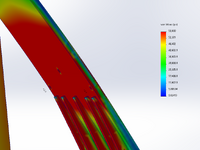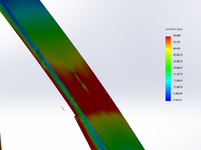Berettapx4
Student
- Jul 22, 2025
- 3
Hi everyone,
We briefly studied FEA with Solidworks and I am designing something that will be handling a certain load. This is the result I got from running static analysis in FEA. Everything on red would be past tensile strength, If I'm the one interpreting this result, I would say it will fail. But the plate (1 1/2" ASTM A36 plate) are only partially covered with stresses that exceeds the tensile strength. Because bottom and top portion of the plate is red while the middle section of it is experiencing less stress.
My question is, will it break and snap in half or there's a possibility that portion of it will just experience permanent deformation since the plate is not fully under the stress that exceeds tensile strength?
I know there's no accurate answer without testing it in real world but I would love to hear and learn from the people that does FEA frequently.
We briefly studied FEA with Solidworks and I am designing something that will be handling a certain load. This is the result I got from running static analysis in FEA. Everything on red would be past tensile strength, If I'm the one interpreting this result, I would say it will fail. But the plate (1 1/2" ASTM A36 plate) are only partially covered with stresses that exceeds the tensile strength. Because bottom and top portion of the plate is red while the middle section of it is experiencing less stress.
My question is, will it break and snap in half or there's a possibility that portion of it will just experience permanent deformation since the plate is not fully under the stress that exceeds tensile strength?
I know there's no accurate answer without testing it in real world but I would love to hear and learn from the people that does FEA frequently.


